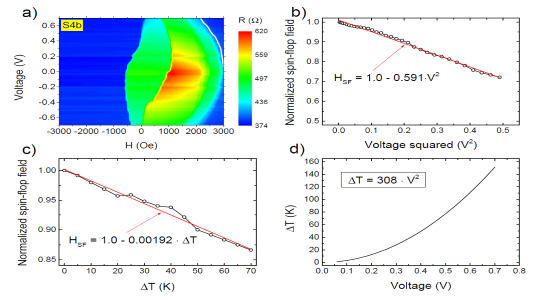Measured switching diagrams of perpendicular magnetic tunnel junctions exhibit unexpected behavior at high voltages associated with significant heating of the storage layer.
The boundaries deviate from the critical lines corresponding to the coercive field, which contrasts with the theoretically predicted behavior of a standard macrospin-based model. In this paper, we are proposing a modified model which considers the Joule heating during the writing pulse.
A large number of studies related to spin transfer torque switching in magnetic tunnel junctions (MTJs) were conducted over the past few years in support of the development of spin transfer torque magnetic random access memory. This memory uses as storage elements out-of-plane magnetized MgO-based MTJs exhibiting large tunnel magnetoresistance and strong interfacial perpendicular magnetic anisotropy. This anisotropy originates from the MgO/FeCoB interface which provides high thermal stability of the storage layer magnetization. Recent experimental observations and theoretical studies of such diagrams give an almost complete description of STT-induced switching processes in MTJ. However, at high voltages, most experimental diagrams show a deviation from the theoretically predicted behavior. This effect might be associated with the heating due to Joule dissipation around the tunnel barrier and the resulting variation of the storage layer magnetic properties. In this paper, we present our experimental studies and their theoretical description using the macrospin model that takes into account the heating effects. These results point out to the strong influence of the Joule heating on switching abilities of MTJs at high voltages. We measured the stability V-H diagrams in a variety of samples of different composition and diameters in which significant Joule heating take place during STT writing. We explained the high voltage anomaly of the V-H diagrams as due to heating effects in the storage layer.
Two mechanisms of the asymmetry of the critical lines for positive and negative voltages were suggested: heating asymmetry induced by the asymmetric inelastic relaxation of tunneling electrons and heating asymmetry due to the difference of the resistance in P and AP states. The second mechanism makes the largest contribution to the heating asymmetry versus bias voltage when the TMR is large. We also developed a modified macrospin-based model by including a dependence on the applied voltage, of the material parameters such as uniaxial anisotropy constant, spontaneous magnetization and STT prefactor. The model was used to numerically simulate the V-H diagrams. Very good agreement with the experimental results was obtained. The presented model can be used in pMTJ-based MRAM circuits design to take into account such unusual behavior of the MTJ properties at high bias voltages. Moreover, the predictions presented in this study can be extrapolated to similar multilayer stacks used for other applications.
(a) Experimental stability diagram measured under dc voltage
(b) Linear fit of normalized spin-flop field-voltage squared dependence.
(c) Linear fit of normalized spin-flop field-temperature variation dependence.
(d) Temperature elevation due to current flow versus voltage
Team: MRAM, Theory and Simulation
Funding: ERC Advanced Grant MAGICAL no 669204
Further reading: Impact of Joule heating on the stability phase diagrams of perpendicular magnetic tunnel junctions, N. Strelkov et al, Phys. Rev. B 98, 214410, DOI: 10.1103/PhysRevB.98.214410
Contact: lucian.prejbeanu@cea.fr , bernard.dieny@cea.fr, liliana.buda@cea.fr





